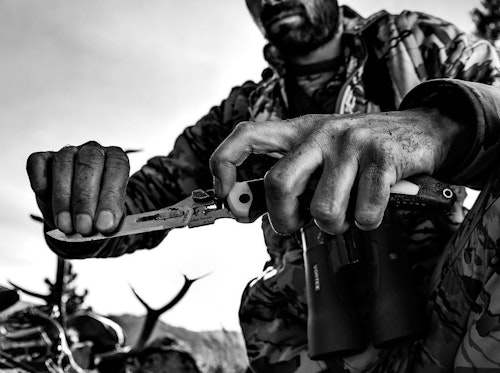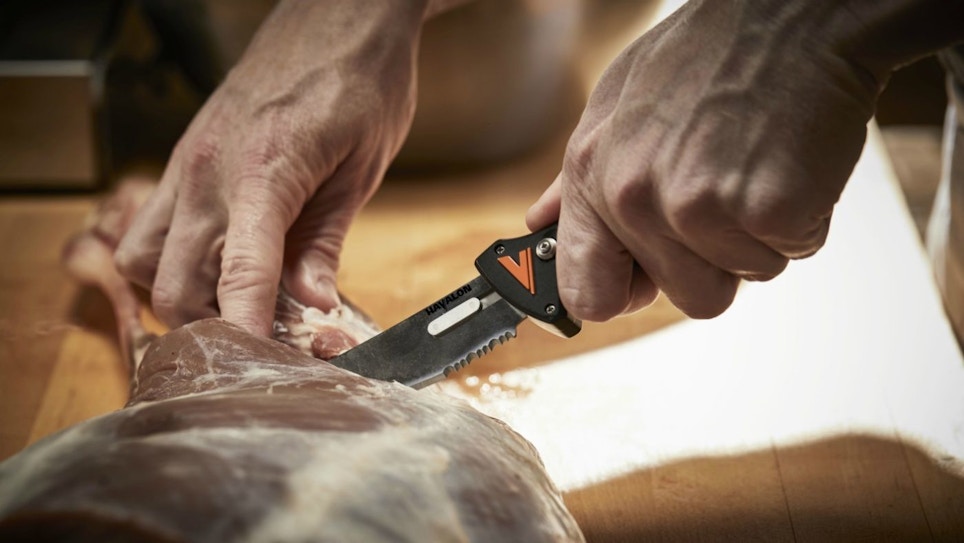There are all kinds of knife buyers, from the spouse who wants to purchase an edged gift for a loved one to the hunting junkie who wants latest in game care cutlery. Each want a product that’s affordable and functional and that reflects quality craftsmanship. Unfortunately, most knife buyers have little, if any, salient knowledge regarding the product they’re interested in purchasing. It is, therefore, incumbent upon the sales person to assist the customer in making an informed decision.
Fixed or Folding
Knives can be broadly separated into two categories: fixed-blade and folding. Fixed-blade knives consist of a single unit that includes blade, guard and handle. The most important considerations in this category are: Full-length, full-width blade extension (tang) that forms the handle, some type of protective measure (guard) to keep the hand from accidentally coming into contact with the blade edge, a handle the fits the grip pocket of the hand, and either a blade cover or sheath to provide a mechanism for owner carry. It should be noted that only about one in five knife buyers make a fixed-blade purchase. Those who do tend to be older and more conservative males with considerable knife use experience. The fact that there is nothing to malfunction and no need to do anything more than to put the blade to work appeals to those experienced with edged tool performance — especially when they find themselves a long way away from camp.
A folding knife is nothing more than a fixed-blade with a main pin that acts as a hinge, allowing the blade to work against a spring and fold into handle. Opening and closing the knife is accomplished by means of either a nail nick (indentation on the blade) or a protrusion or lever that allows for one-hand opening. Some folders have a provision for locking (bracing) the blade in the opening position, which prevents accidental blade closure and offers a measure of user safety. Those who use folders as hunting knives tend to favor a locking blade, since the knife operates as a fixed-blade when open but has less bulk when closed and can be safely carried on the belt or person more easily.
Blade Length
Both the user and the medium in which the blade is put to use should dictate the length of a knife blade. A tiny pocketknife can easily deal with opening the mail, trimming loose threads and similar cutting assignments. The blade on such knives need only be an inch or so in length. For more serious work, a longer blade and a larger knife is an appropriate choice. The length of the user’s index finger can determine a good measure of blade length. If the blade is too long, it puts the knife user at a distance from the actual work, making it difficult to control the cutting action of the blade. The opposite is true when the blade is too short — it draws the user into the work, making it all that more challenging to control blade movement. Hunters generally select blades between 3 to 4 inches in length. This enables the user to control blade movement and provides all the cutting force necessary for even the toughest assignments.
Blade Shape
There are as many options for blade shape or pattern as there are for length. The two most popular shapes seen on hunting knives are the drop point and the clip point. The drop point features a convex curve on the blade spine, extending from the handle to tip, which allow the spine to be thicker and stronger. This shape also aligns the tip with the center axis of the blade. This blade shape is often the choice of those who handle all of their own game care chores, such as field dressing, skinning and field butchering.
Clip point blades differ in that the forward one-third of the blade is “clipped” off (either straight or concave), producing an extremely fine blade point. While less resistant to lateral stress than the drop point, the clip point is somewhat more useful in detailed trophy work like head skin cape removal and similar chores. This blade shape is often found on many general-use hunting knives. Trailing point blades are the most unusual of blade shapes in that they feature an upward blade spine curve to an elevated point that rises above the handle, thereby creating a more sweeping blade belly. Those who handle all of their own hide removal chores often favor this design. Since the blade point is elevated, an accidental hide puncture during the skinning process is less likely. Likewise, cutting into the underlying muscular tissue, thereby creating an avenue for subsequent bacterial growth, is not a problem.
Blade Steel
The steel component of a knife blade is often the subject of considerable discussion, with proponents of a particular formulation claiming that their proprietary blade steel holds an edge longer and is easier to sharpen. In reality, both edge-holding and sharpening ease are at opposite ends of the blade steel spectrum. If a particular steel is capable of enhanced edge retention, by definition it will be resistant to edge abrasion. Likewise, should a particular blade steel offer quick and easy edge maintenance (sharpening), it has little resistance to abrasion and will dull quickly. No blade steel known to man can hold an edge and at the same time offer easy sharpening. What cutlery manufacturers have done is heat treat their steel in a range that provides a combination of reasonable edge retention and equitable sharpening ease.
This will be reflected by a Rockwell (Rc) hardness scale numerical value ranging from Rc 55 to 66, with the lower value being relatively soft and the higher value extremely hard. Knife blades exhibiting a Rockwell value of Rc 57-59 will offer the best combination of edge holding and sharpening ease.
Blade steel formulations are like recipes for chocolate chip cookies — everybody has their favorite. Steel used in knife blades is produced both domestically and off shore. Depending on its point of origin, the price of blade steel will determine the competitive nature of the cutlery product. For this reason, many American cutlery firms use domestic designers but have products produced offshore to remain competitive in the marketplace. Regardless of point of manufacturing origin, if quality materials and craftsmanship are used and the product is warranted, the purchaser can be assured of inherent value.
Both carbon and stainless steels are used in blade manufacturers. Obviously, stainless formulations are easier to maintain, especially when you consider the caustic nature of bodily fluids encountered during field care of game and fish. To be considered “stainless,” blade steel must possess a minimum of 12 percent chromium, and higher is better in high humidity environments. Most manufacturers will provide information about the steel formulation used in their knives, however, terms like “surgical steel” have little bearing on the formulation or quality of particular steel. Surgical instruments are disposable and not made from the best grade of steel. It is always best to look beyond advertising description to the actual grade of steel to know what is used. The formulation of that steel can be found through a simple internet search; from there, the Rockwell hardness value will provide salient information about edge retention and sharpening ease.

Handles
The handle or grip is another consideration when guiding your customer to the right knife. On a fixed-blade knife, the best designs feature a handle that’s nothing more than an extension (blade tang) of the blade itself and covered with something that provides a gripping surface. A host of materials — leather, bone, stag, molded plastic and more — can be used, with the key element being user comfort. Moreover, the grip surface should have some measure of contact adherence, since when the knife is used in fish and game field care, blood and other fluids can make the knife slippery in the hand. Folding knives also should be able to be held without discomfort, so look for folders that feature rounded angles and grip-filling handle scales.
Carrying Containment
Transport of a knife on your person must include protection from direct contact with the sharpened edge of the blade. To accomplish this, some type of sheath or blade cover must be employed on a fixed-blade knife. Tanned leather is a popular material, however, in recent years, heavy fabrics (Cordura nylon) and molded thermoplastics (Kydex) have also been used in sheath construction. Sheath construction should reflect the same quality as the knives they house. Poorly made sheaths with loose stitching, thin leather and inadequate containment are indicative of the quality of the knives they hold. Rather than an afterthought, the sheath should be an integral component of the knife itself.
Of course, a folding knife doesn’t need a sheath, since the blade safely folds into the case. However, a compact carrying case does allow the user to carry the knife conveniently on the belt, making for easy access. In recent years, the external clip has been developed so that a folder can be attached to the edge of almost anything, like a pocket or a boot. Clips do offer enhance convenience and alternative carry positioning, but they negatively impact hand-to-knife contact during extended usage. The choice here is based on personal preference and lifestyle. A belt case might look out of place, whereas a simple clip may not be so obvious.
The bottom line: Knives are among man’s oldest tools. As tool users, we set ourselves apart by being able to aggressively manipulate our environment. A knife should provide the comfort of knowing that that farther away from camp we find ourselves, the greater the importance of that edged tool in either our personal survival or protecting the integrity of whatever fish and game we harvest for the table.
It’s likely that your customers don’t know what they’re looking for when they come in to buy a knife. With a little bit of knowledge about shape, steel, handles and carrying options, you can guide them to the right knife.

Replaceable-Blade Knives
While blade edge maintenance is important for safe knife use, most knife owners have a serious challenge when it comes to sharpening. To overcome this, replaceable-blade knives have made their appearance in the marketplace. Taking a cue from the medical industry, where surgical scalpels utilize disposal blades, similar technology has entered the outdoor cutlery arena. Interestingly, physicians who hunt and fish not only use scalpels in their professional work, but also for basic game care needs (field dressing, skinning and butchery).
Havalon, a pioneer in this arena, created a folding mechanism that made the scalpel concept strong and compact enough for hunters. Weighing only a few ounces, including extra blades, their knives eliminated the need to carry a sharpening tool. Over the years, Havalon improved replaceable blades to resist twisting and better facilitate blade removal. Knife handles have also advanced with various styles, colors and shapes. In addition to their single-blade tools, a two-bladed design mating a classic AUS-8 stainless clip pattern blade and a Havalon replaceable blade in the same folding knife frame has been introduced for hunters who want the best of both worlds. And Havalon continues to expand its line of replaceable blade cutlery to meet the needs of sportsmen and women.
Since it’s difficult to contain a good idea, the replaceable-blade concept has spread to several other cutlery manufacturers, with firms like Gerber, Outdoor Edge and others offering similar products. Many outdoor folks have an allegiance to a particular brand, therefore, the inclusion of the replaceable-blade concept in a wider number of knife lines provides the opportunity for many to try out this new technology.







